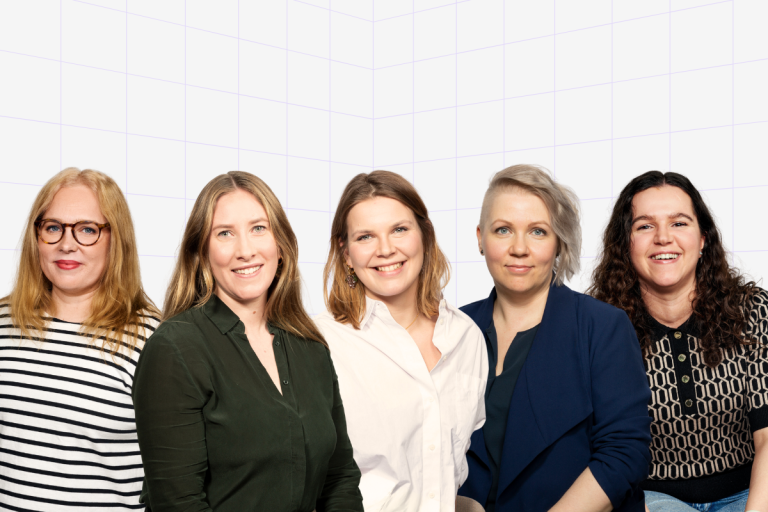
Culture
Equality is not yet achieved – not even in the IT industry
Hion
How is gender equality in the IT industry seen through the eyes of the women at Hion? What should be developed? We asked a few women from Hion to share their thoughts in honor of International Women's Day.
We see that a diverse and thriving work community is an essential part of our growth and strategy. That’s why it’s important to regularly assess where we stand in this regard. The IT sector has historically been male-dominated. Currently, 31% of our team at Hion are women, above the industry average in Finland, which has historically ranged between 20-29%.
How do Hion’s female experts see the state of the industry? What areas need improvement?
The IT industry provides care and meaningful work
The interviewees value many aspects of the IT industry.
Tea, the Sustainability and Design Lead, appreciates the industry’s fast pace of change and the potential to improve ethical practices. A good salary and benefits, as well as the opportunity to do meaningful work, are also a bonus.
“The industry is changing rapidly, and there are always things that could be done more ethically. The digital world is a representation of the physical world. Probably all the problems that exist in the physical world manifest in some way in the digital environment, and we need to talk about them and move the world towards a more just and ethical direction in that regard.” -Tea Dickman
Senior Designer Jenny Järvinen sees the opportunities to move around within the field and work on projects that interest her as a positive aspect of the industry. Multidisciplinary teams and remote work opportunities also receive praise. Tech Lead Tiia Ohtokallio, on the other hand, commends the way the IT sector takes care of its employees, and Testing Engineer Heli Köck appreciates the flexibility of the industry.
“The IT industry is truly wonderful. I dare say that in no other field are employees taken such good care of as in the IT sector; this is influenced by the fierce competition for talent in the private sector. The flip side of the industry is that keeping one’s skills sharp requires dedication and personal projects in one’s own time. Especially now in the age of AI, there can be a significant risk of one’s skills becoming outdated, and this is something everyone needs to take personal responsibility for.” -Tiia Ohtokallio
“One of the biggest advantages of this industry is its flexibility. I personally chose to return to work part-time just 3.5 months after parental leave. It allowed me to do what I love while still being at home with my baby. Remote work, a good napper, and an employer who truly listened made it possible to balance work and family life smoothly.” -Heli Köck
Our Chief Design Officer, Katja Vakula, highlights a larger shift that has been seen in women’s courage to found companies that reflect their values.
“Women have boldly founded companies that align with their values and drive change – also within the IT industry. Today, women are more aware of their strengths, values, and potential to create positive change, and they’ve learned to unapologetically make use of that. We need more of this!” -Katja Vakula
The world is not ready
The interviews also revealed familiar issues related to gender equality in the IT industry. One key theme was the male dominance in the field, which is reflected both in company culture and recruitment practices.
Respondents pointed out that companies may unknowingly favor men in job postings and role descriptions. Several studies have been conducted on this topic.*
Furthermore, leveraging one’s own networks in recruitment can lead to women and other minorities being excluded.
The interviewees also brought up the challenges women face in salary development and advancement to leadership positions. They felt that even though women are just as competent as men, their career progression in our field can be slower.
This aligns with TEK’s research, which states that an unexplained gender pay gap still exists in the technology sector.
According to the research, the unexplained pay gap between women and men is 5.5 percent. This means that even when differences in experience, roles, industries, and education are taken into account, women are still paid an average of 5.5 percent less than men for the same work
The study also found that women are more likely to be in lower-paying industries and roles, which explains part of the pay gap. However, a significant portion of the pay gap remains unexplained, indicating that gender-based discrimination still exists in the labor market.
“Overall, women still don’t progress as smoothly within organizations as their male counterparts. This is where we are different and progressive at Hion: even our leadership team is more than 50% women, and we also have good female representation at the managerial level. However, if we look at the broader picture, unfortunately, this is not yet the case.” -Tea Dickman
The responses also highlighted that double standards still exist between women and men. The same behavior might be interpreted differently depending on whether it’s a man or a woman. For example, women’s directness may not be valued in the same way as men’s, and the same behavior might be seen as assertiveness in men but as being difficult in women.
The responses also emphasized that women are often expected to work harder to succeed and are evaluated more strictly than men. It’s important to recognize and question such thought patterns and biases that can affect how women are treated.
How is Hion working to promote equality?
We want to act effectively and systematically develop our operations with an open approach. For Equality Day and International Women’s Day, we are involving all Hion team members to share their observations and suggestions on how we can become even more equal in our practices. We will share the key findings and development ideas raised during this process on our blog throughout the spring.
We are currently in the process of setting DEI (Diversity, Equity, and Inclusion) goals, and through this, we will also be monitoring things like the proportion of women in our staff and the realization of pay equity more closely.
Sources:
Teknologiateollisuus, henkilöstö
Naisten ja miesten palkat tekniikan alalla, TEK
* Job advertisements that use masculine wording are less appealing to women, 2011
* Gender-fair language in job advertisements: A cross-linguistic and cross-cultural analysis, 2017
* Wording of advertisements influences women’s intention to apply for career opportunities, 2014


